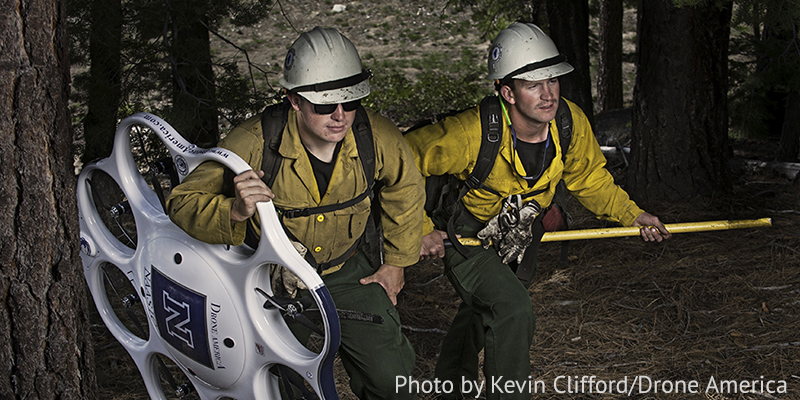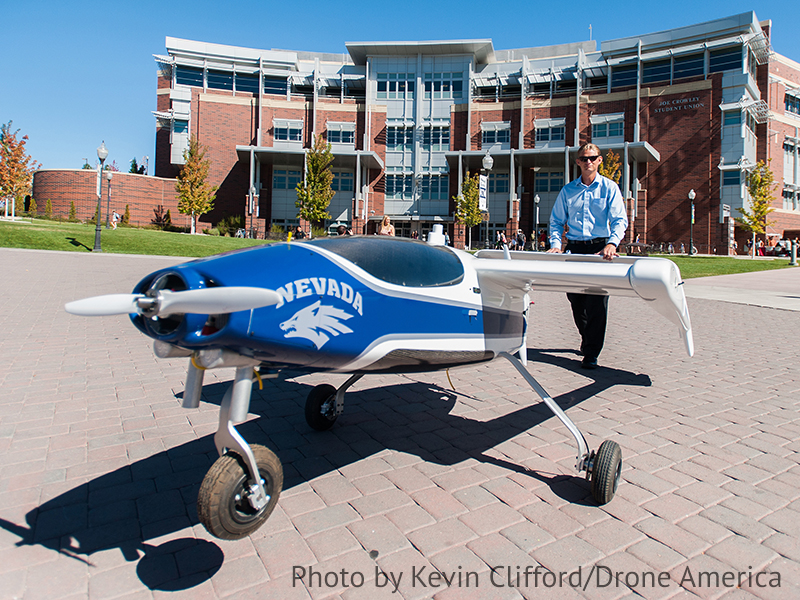Search crews may add drones to tool box

Wildland Fire crews with Drone America’s DAx8 in Lake Tahoe.
Photo/Kevin Clifford/Drone America
By Jessie Marchesseau
If you happen to get lost in the wilderness and need to call search and rescue sometime in the future, it’s possible you may spot a drone overhead looking for you.
As unmanned aerial systems, also known as drones, become more commonplace, the various uses for them are quickly multiplying. From monitoring wildlife populations to taking photos of available real estate, there seems to be no shortage of uses for these lightweight flying devices.
Even in an industry such as search and rescue which relies mainly on manpower to complete its missions, UAS may be able provide useful insights, adding another layer to rescue efforts.
In fact, in July 2015, El Dorado County SAR was able to use a National Guard drone for the first time in a search and rescue mission. The search was for a missing motorcyclist in the northern part of El Dorado County. Deputy Greg Almos, assigned officer to emergency services and search and rescue for El Dorado County, said that while the drone did not locate the subject, it did give them clues regarding where to look.
“In every search and rescue, the use of human beings, equipment or technology is really just a clue-finder that leads to finding an individual,” he told Lake Tahoe News.
That search proved to be a unique situation where the UAS was available and there was an urgent need in the particular situation. The opportunity to use a drone for aiding a search in El Dorado County has not come up since. Almos said it would not be ideal for all situations, but he could see a UAS being useful for future searches in areas such as Horsetail Falls and Eagle Falls, both popular hiking areas in the summer months.

Drone America and their Phoebus Mk.III at UNR.
Photo/Kevin Clifford/Drone America
Carol Caman, a rescue member of the Douglas County Search and Rescue, recalled one rescue effort in particular where she believes a drone would have been helpful. When an aircraft went down in Lyon County a few years ago, it took SAR volunteers and helicopters three days to locate the wreckage, partly due to a winter storm moving through. A drone, she said, would have been able to fly lower and slower than the helicopters and do it in the storm with less danger to humans, possibly locating the downed plane much sooner.
In April, Caman attended the first annual UAS Search and Rescue Symposium in Reno hosted by the UNR’s Nevada Advanced Autonomous Systems Innovation Center.
Warren Rapp, business development director for NAASIC, said they decided to put on the symposium because the center is constantly being contacted by search and rescue organizations with questions about UAS.
The symposium was free to SAR volunteers and covered a number of topics including FAA regulations.
The FAA has allowed limited use of UAS for public missions such as firefighting, disaster relief and search and rescue since 1990. Recently, drones were used during the Texas and Louisiana floods to locate stranded individuals and to distribute essential supplies such as water to those people.
Rapp suggested that such delivery of supplies is another way drones could aid search and rescue operations. The larger fixed-wing drones would be able to carry much-needed first aid kits, small heaters or water to someone in the wilderness quicker than a team could reach them on foot, in some cases alleviating the need for a rescue party altogether.
However, he and Caman stressed that UAS would not in any way replace the humans of search and rescue operations. Rather, they would act as another tool to help people in need.
“It will save you man hours,” Rapp told Lake Tahoe News. “If your crew is only seven and you have a thousand acres to search, a drone may help you funnel people to a certain area with clues.”
Caman compared it to another recent technological advancement: cell phone forensics. Lost or stranded individuals can now often be located via the GPS in their cell phones. This technology has only been available to SAR teams for a few years, but has become an integral part of their search operations. Many subjects are now located very quickly thanks to this technology.
“I think it’s a good idea to get the best tools you can to help people out,” Caman told LTN.
The Douglas County SAR is currently discussing the possibility of getting a UAS or acquiring one in conjunction with another nearby SAR, however they are still in the early stages of the process. There are a lot of questions to answer and hurdles to overcome in order to make that happen, Caman said.
One is financing. Drones cost anywhere from a couple hundred dollars to more than a hundred thousand depending on type and what it needs to be equipped with.
This raises the question, which kind is right for the varied terrain of Douglas County? Some have infrared cameras, heat-sensing cameras, or high-def cameras. There are quad-copters and fixed wing. Some are good for flying in tight areas like along cliffs and down ravines. Other fly best low and flat. Once a style and price is in sight, they must decide if the cost is worth the benefit gained from it.
There is also the question of manpower to use it, necessary training, and the issue of FAA rules for UAS being currently up in the air.
While no one interviewed reported having experienced resistance to the use of drones within the search and rescue community, they do still see a lot of unknowns. El Dorado County SAR has discussed the prospect of acquiring a drone, but is not moving forward with anything at the moment, choosing to wait until some of these questions are answered. And though Douglas County is moving forward with their discussions, they are doing so slowly.
“We want to make sure we buy the right equipment for here in Douglas County and that we incorporate it into our team rather than make it the focus of our team,” Caman said.
So while you may not see a fleet of search and rescue drones buzzing around Lake Tahoe in the very near future, it is on the horizon.


